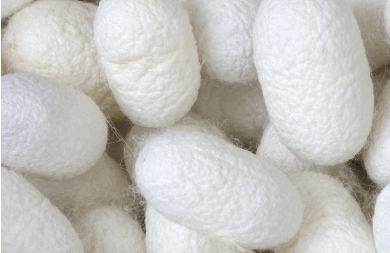 INTRODUCTION INTRODUCTION
FIBRE CATEGORY: NATURAL PROTEIN FIBRE
Silk is categorised as a natural protein fibre, and is secreted as liquid silk by the moth pupa as a fine single filament as they form their protective cocoons before metamorphosis. The liquid silk is made of a protein called Fibroin, and coated in a water soluble protective gum called sericin. Insects that metamorphose primarily secrete silks, but substances categorised by the term ‘silk’ can also be produced by web spinners, such as spiders. Several other insects produce silks, however it is only the silk derived from moth caterpillars that has been used extensively for textiles. The best known of all the natural silk fibres is produced by the larvae of the silkworm Bombyx mori, which is only reared in captivity. This industrial scale cultivation is known as sericulture. Cultivated silkworm pupae are killed before the adult moth has chance to emerge by dipping in boiling water, steaming, heating or piercing with a needle, resulting in a cocoon that can be unravelled in one continuous thread. Textiles produced from this single filament tend to be much stronger.
 It is only the filament of the Bombyx Mori moth, which through many centuries of cultivation has become a blind and flightless creature, that is capable of producing the much prized filament that is smoother, and finer and than that of other silk moths. It is only the filament of the Bombyx Mori moth, which through many centuries of cultivation has become a blind and flightless creature, that is capable of producing the much prized filament that is smoother, and finer and than that of other silk moths.
Silk fabric is traditionally measured in Mommes, which is a unit of weight used to quantify the density of silk. For example 1 momme= 3.6g of silk fabric per yard: a 17 momme fabric would equal 61,2g per yard.
Wild Silk
There are over two hundred varieties of wild silk moths found in locations all over the world, however most of these produce silk filaments that are generally irregular or flattened in form. Flatter threads tend to tangle, and can therefore break easily if unwound.
Wild silks or tussah silks (also spelled tusah) are produced by caterpillars other than the cultivated mulberry silk worm Bombyx mori.
A wide variety of wild silks have been produced in China, India and Europe from the earliest times, but the scale of production has always been smaller than that of cultivated silk.
Wild silks differ greatly in colour gradation and texture depending on the species, climate and food source, but are generally characterised by an uneven and low sheen appearance and rough, slubby feel. The reason for this is that the cocoons are gathered in the wild and are essentially ‘damaged’ by the emerging moth eating its way out of the cocoon; therefore the single thread that makes up the cocoon has been torn or shredded into shorter lengths, this lends wild silks their characteristic natural slubby ‘bark’ like effect and dry textured handle. are generally characterised by an uneven and low sheen appearance and rough, slubby feel. The reason for this is that the cocoons are gathered in the wild and are essentially ‘damaged’ by the emerging moth eating its way out of the cocoon; therefore the single thread that makes up the cocoon has been torn or shredded into shorter lengths, this lends wild silks their characteristic natural slubby ‘bark’ like effect and dry textured handle.
|





